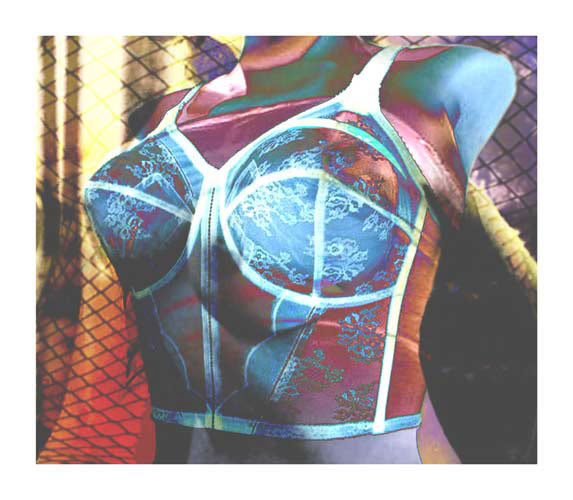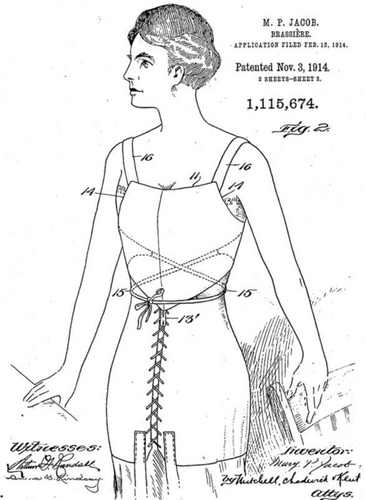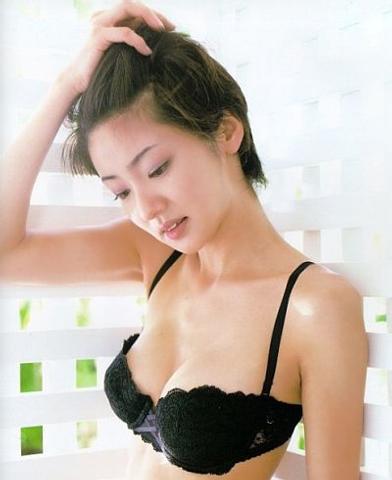| The History of the Corset & Brassiere
The Fashion eZine - Corsetry
Today, if women wish to wear brassieres, they can buy brassieres that combines playfulness and practicality. They can boost their breasts with comfortable and effective brassieres. They can wear basic brassieres, lavish brassieres or luxurious brassieres. You name it! The corset and the brassiere are articles of clothing worn to shape or constrict the torso, whether as underclothing or as outer decoration. A garment of great antiquity, the corset goes back at least to the 2nd millennium BC, when it was worn by Cretan women of the Minoan Bronze Age. Minoan women wore them as an outer garment to clinch the waist and raise the breasts.It was definitely a strong fashion statement by a society who worshipped female divinities. Egyptian women wore a tight narrow band under the bust to give support and make up part of their outside costume. Hebrew women wore undergarment (Isaiah 3, 23). Greek women wore a woolen band. Roman women wore a band to flatten their breasts. In the Middle Ages small, firm breasts were back in style, and women wore a multitude of corset-like variations - the cotte, the bliaunt, the surcot - which slipped on over their dresses and hugged the breasts tightly. The guÍpiŤre, or waspie, as a modern article of underclothing for clinching the waist, is only one form the female corset has taken. It has varied with the changing concepts of the ideal figure. Between about 1550 and 1660, corsets had the purpose of flattening the waist, the stomach and the breasts, molding the female body into unnatural shapes. The padded silhouette came into being, with a flat stomach, narrow waist, and cone-shaped bust. What was often called "a fit of the vapors" - a symbol of feminine weakness - was actually the result of too much pressure applied to the stomach and solar plexus, causing women to faint at the drop of a hat.The corsets were reinforced by busks, made generally of wood. The much-embroidered and sometimes jeweled stomacher was a kind of outer corset.
After 1660 the corset became shorter and was so shaped as to support and accentuate the breasts. Polemics against tight corsets, especially boned corsets, are common in literature from the late 17th century onward, It went out of fashion briefly after the French Revolution during the ascendancy of the Empire fashion, which were Greek, fine and body-clinging. But the corset returned about 1810. The corsets compressed breasts from below to make them bulge upward. The fashion was for wide-set breasts, which were achieved by a complex system of boning, invented by the corset-maker Leroy and known as "divorces." By that time, corsets were made of damask, satin or brocaded silk, beautified with embroidery, laces and ribbons. The styles were woven without seams for greater smoothness. The corsets were reinforced with whalebone and metal. Metal eyelets replaced the weaker embroidered ones. "Instant release" and "lazy lacing" systems of pulleys allowed women to lace and unlace themselves. The corsets changed throughout the 19th century with the ever-changing shape of dresses. By the 1840s, women's figures were completed exaggerated: huge full sleeves, a miniscule corseted waist, followed by whalebone hoops and crinolines covered with yards and yards of fabric, flounces and trims. A waist that could be encircled by a man's two hands was held up as the model to emulate, and women laced themselves tighter than ever. In the end of the 19th century, the crinoline vanished but the corset stayed, now accompanied by a bustle in back, for a distinctive hourglass silhouette. The projecting "bustle" effect was first achieved with a horsehair pad, and then with a metal frame that meant a woman could only sit with the very tip of her bottom on the very edge of the chair. Women were so tightly corseted that they could not bend over. And the corset itself was hung with a combined system of garters and suspenders to hold up the stockings - a system as complicated, some said, as rigging a ship. The idea of the "artificial breast" was introduced. Designed to be worn in a corset, these were made of chamois leather, quilted satin, India rubber - one style could even be inflated at will! In the 20th century, the corset reached new heights. Models became more numerous and more specialized. There were corsets for morning (lightly boned), bathing at the seaside (unboned), horseback riding (elasticized at the hips), riding a velocipede (made of jersey), and much more. Some corsets came with their own perfumed sachet hanging in the center. Others were crafted of white satin, especially for wearing to a ball. In the end of the 20th century , women continued to wear corsets - now lacing down to the knee - but the tide of public opinion was turning against them. As early as about 1870, women in the artistic coterie promoting Aestheticism wore dresses with an uncorseted look which provided more freedom of movement. Neither of those designs became high fashion, however, and corsets continued to be worn until the 1920s, with the advent of straight, unwaisted clothes. In 1908, when clothes with fluid lines began to be designed to be worn without corsets. Popular dancers Isadora Duncan and Loie Fuller reintroduced the ancient Greek idea of formless, free-flowing clothes - and no pinched waists. Couturier Madeleine Vionnet banished the corset and cut her dresses on the bias to provide more freedom of movement The corset was greatly modified at the beginning of the 20th century: it was shorter and no longer supported the breasts, leading to the invention of the brassiere in 1912 by a Paris couturiere, Madame Cadolle.
In 1913, a young American woman Mary Phelps Jacob also invented a new type of bra made of two handkerchiefs and pink ribbon. The bra was very, very soft, short, and designed to divide the breasts in a natural way. She sold her patent to the Warner Corset Company for the sum of USD 1,500, and the rest is history. That garment and the Cavalieri maillot, a topless corset made of elastic material that was invented in 1913 were the prototypes of the brassiere and girdle (in England called the belt) of the 1930s. The Cavalieri maillot was a girdle that were shorter and were more pliable than the corset. The reason why the Cavalieri maillot coupled with the modern brassiere replaced the corset as an everyday garment was the practical consequences of WW I. While the men were fighting at the front, wome were on the homefront, labouring in thre factories or working in the fields. Corsets were abandoned in favour of the more Cavalieri maillot coupled with the modern brassiere because this combination meant more freedom of movement. In the 1920s, American women led the way with their breast-minimizing bras, loose chemises, and other promoters of the new "flat chest." In 1927, William Rosenthal was granted a patent for his "uplift" brassiere. This was the original Maidenform brassiere.By the 1930's, bras were becoming big business. They were sexier and better quality. In 1935, the Warner Corset Company introduced the AlphaBet bra line which first offered women the choice of cup sizes.The brassieres were developed with fitted cups, sizes A, B, C, D and E and elastic straps, and variations were created with padded cups and underwires to enhance the breasts. The fitted cups was made to consider the needs of the physical development of the female body. The corselette, a one-piece garment combining brassiere and girdle, was developed in the 1930s and is still worn. In the late 1930s, there was an attempt by designers to bring back the boned corset, but WW II cut short most stylish innovations. In the 1950s, brassieres and girdles were used to exaggerate the feminine form, and the new pointed bra had exaggerated, cone-shaped cups. Missile-solo breasts were obtained by wearing constructed bras with circular top-stitching. Jane Russel wore an aerodynamic bra reinforced with wiring when she played the female lead in the movie "The Outlaw". Warner developed a "Merry Widow" in 1951, a combination of elasticized satin girdle and wired bra that was designed to go beneath evening wear. The main innovations of the brassiere, especially since the 1960's, incorporated improved synthetic-elastic materials. This bra was short-lived with the advent of the 60's and the "braless" movement. The women set fire to their brassieres because of their new emancipation based on feminism. The fashion for going braless would result in many lingerie manufacturers going out of business. But, fortunately, the brassieres were soon to be reintroduced because the majority of women whose breasts were too large to be comfortable for long without a bra.The "no-bra" look became popular in the 1970's, and this soft feminine look has carried over to today. In the 1980s, the rounded breast and well-padded bosom were suddenly back, and wired bras became number one in sales. The latest influence during the 90's was the Wonderbra and the Super-Uplift designed to enhance cleavage. Today, women are attracted by a dazzling brassiere collection of styles, colors, and textures. If a woman wants to enhance her silhouette, she can easily do so, without having to endure the tortures of ages past. The new seamless support garments mold the figure gently but firmly, in revolutionary new blends of breathable fabric. Bras can be found with or without padding, and the new ultra-padded bras can create amazing cleavage effects for special occasions, ie. romantic evenings. Yet above all, brassieres are fun, practical and sexy. It's a personal pleasure, a way to pamper yourself and indulge your romantic and sexual nature.
See Also:
|
|
The Cultural History of BreastsThe story of the breasts can be compared with a debate of which most of the contributors are men. The breasts have always been a charming object for poetic, religious, erotical and medical debates. Finally, when the breasts are described from the female point-of-view, the great mythical story is replaced by many small stories of suppression.
Women have seldom had the entire disposal of their breasts. The breasts have been of too great importance in the mentality of the western cultures to be left to their true owners, the women. The breasts have been the object of both political and spiritual conquest. The breasts have been loved and hated, praised and defiled. The breasts have been an object in the interest of the church, the nations and the consumers. The breasts can sell anything: red apples, alcohol, political slogans and melons. If the marketing shall be successful, the breasts must have an mystical glory. This can only be allowed in areas which are under inspection. Sometimes it can be assumed that the breasts are the hidden supreme authority in the world. What is the reasons for the fascination of the female breasts through centuries? An explanation can be found in the milk production of the breasts. The weak life is nourished by the soft-formed nipples. Babies of all kinds of communities and classes have found life and nourishment by suckling the women's breasts. The breast have been sanctified in the pictures of Jesus and the breast-feeding Mary. Although Mary breast-feeded like other women, she was unique and different. The distance between Mary and ordinary women was often underlined by the breast-feeding breast was like a pasted unripe apple. Consequently, the nourishing breast of Mary was not human-like breasts. When the breast-feeding breast was naked, the breast got soon a secular life. The breast was moved from the church to the secular men, and the breasts is dramatically erotized. "The man is happy who can fill you with milk, and who can transform the virgin breasts into a beautiful and perfect woman." This proclamation is to be found in a poem written by Clemant Merot in the first half of the 16th century. The poem is fascinating because the breasts stimulated both the male desire and the male pride. The male ecstacy express a phantasy of power to start the process of milk production.
In the 14th century the naked, small breasts of the Italian madonna symbolized the nourishment of God, and the amount of naked breasts which is to be found in paintings and poetry in the 14th century, is a part of a cultural and social revolution in Europe. The breasts were one of many objects which could be conquered by active men. The breasts were a object which could be taken from the priests. In the Renessaince France and Italy turned the female body, especially the breasts, into a focal point of the advanced civilization. Apart from nurses, farmers' wives and witches, the breasts in paintings are seldom big or heavy. On the contrary, the ideal breasts are floating and rise above the law of gravity. The erotic and naked breasts in the Catholic regions are not to be found in the Protestant regions. The visual appearance of the body which blossomed in the Catholic elite, was very suspect in Protestant circles. Although the naked female body was not to be found, the verbal proclamations transformed the woman into a plate filled with fruit! Generally, the sense of contact was represented by a male hand on a breast in allegorical paintings of the five senses. That the man lay his hands on the breasts was a sign of domination, which corresponded with the exhortation of Christianity that the wife should be submissive to her husband. From the end of the Middle Ages the cult of the erotic breast has characterized the western civilization. The only discernible change have been the change of the ideals of size, form and function. Although the community in the Renessaince expelled the milk producing qualities of the breasts, this function of the breast should return with new strength in the 18th century. Because of the philosophers of the Enlightment and the subsequent development of nations, the breast got an very important function. The breasts were a fire place where the family gathered. Suddenly, nursing got a national function. The breast-feeding breast was sexy even in the upper classes. In a socio-political manifesto written by French women of the upper classes in 1788 the nursing had the function "to strengthen the bond of families, be responsible for the the duties of the woman, force them to be indoors to avoid shameful behaviour and bettling." In the French revolution the nursing is raised to a quasi-mythological niveau, and the iconography of the Revolution was populated by women with naked breasts. In the official manuals the women were encouraged to offer their breasts to their husbands, so that the husbands could rest their heads on them, and to offer their children the breasts to nourish them. Paradoxically, the women had this important function, but they should not take part in the public life.
The new laws guaranteed civil rights to religious minorities and slaves, but not to women! The state took over the church's practice of symbols: As the church was described as a mother who nourishes the believers with the milk of the religion, the nation was described as a mother who offered her breasts to the children of the nation. Nursing was a collective manifesto of a civic virtue, corresponding to Rousseau's philosophical visions in Emile (1762). Rousseau said that the nursing established a closer connection between the mothers and the families, and at the same time it established a fundament to the renewal of the society. In the 19th century the breasts have been used politically by different governments, especially in times of war. The variation in the use of the breasts in the propaganda i.e. in WWI is based on the different national costumes. The political trends was developed out of a specter of political, financial, religious and medical sources, which are to be described as male-dominated institutions. In the end of the 20th century the women began to influence the sexual policy which controlled their breasts. Paradoxically, in the time of the increase in the number of breast cancer, the women got back the control of their breasts. Of course, the history of breast cancer is long, but the increase of the number of registered cases of breast cancer which is experienced by women nowadays, is a historical fact. In opposition to the theories of Sigmund Freud, feminists have concluded that the history of the breasts reveals the fact that men is dominated by breast envy. Because the men cannot have these female attributes, the envy results in an ambivalent male desire. Because this hidden center of power is not to be found on the male body, but is to be found on the female body, it must be controlled and just let out in controlled areas.
| |





